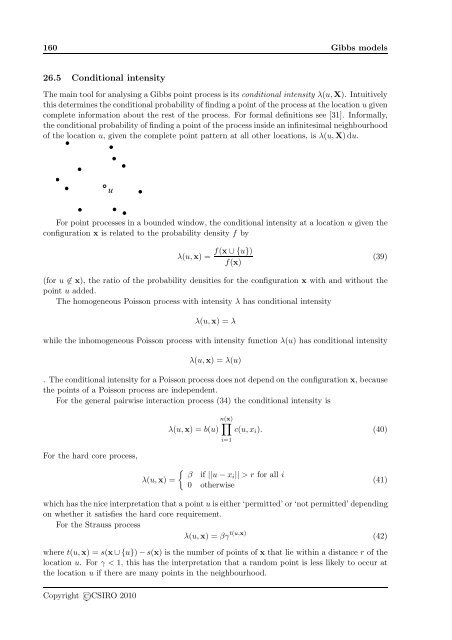Analysing spatial point patterns in R - CSIRO
Analysing spatial point patterns in R - CSIRO
Analysing spatial point patterns in R - CSIRO
Create successful ePaper yourself
Turn your PDF publications into a flip-book with our unique Google optimized e-Paper software.
160 Gibbs models<br />
26.5 Conditional <strong>in</strong>tensity<br />
The ma<strong>in</strong> tool for analys<strong>in</strong>g a Gibbs <strong>po<strong>in</strong>t</strong> process is its conditional <strong>in</strong>tensity λ(u,X). Intuitively<br />
this determ<strong>in</strong>es the conditional probability of f<strong>in</strong>d<strong>in</strong>g a <strong>po<strong>in</strong>t</strong> of the process at the location u given<br />
complete <strong>in</strong>formation about the rest of the process. For formal def<strong>in</strong>itions see [31]. Informally,<br />
the conditional probability of f<strong>in</strong>d<strong>in</strong>g a <strong>po<strong>in</strong>t</strong> of the process <strong>in</strong>side an <strong>in</strong>f<strong>in</strong>itesimal neighbourhood<br />
of the location u, given the complete <strong>po<strong>in</strong>t</strong> pattern at all other locations, is λ(u,X)du.<br />
u<br />
For <strong>po<strong>in</strong>t</strong> processes <strong>in</strong> a bounded w<strong>in</strong>dow, the conditional <strong>in</strong>tensity at a location u given the<br />
configuration x is related to the probability density f by<br />
λ(u,x) =<br />
f(x ∪ {u})<br />
f(x)<br />
(39)<br />
(for u ∉ x), the ratio of the probability densities for the configuration x with and without the<br />
<strong>po<strong>in</strong>t</strong> u added.<br />
The homogeneous Poisson process with <strong>in</strong>tensity λ has conditional <strong>in</strong>tensity<br />
λ(u,x) = λ<br />
while the <strong>in</strong>homogeneous Poisson process with <strong>in</strong>tensity function λ(u) has conditional <strong>in</strong>tensity<br />
λ(u,x) = λ(u)<br />
. The conditional <strong>in</strong>tensity for a Poisson process does not depend on the configuration x, because<br />
the <strong>po<strong>in</strong>t</strong>s of a Poisson process are <strong>in</strong>dependent.<br />
For the general pairwise <strong>in</strong>teraction process (34) the conditional <strong>in</strong>tensity is<br />
For the hard core process,<br />
n(x)<br />
∏<br />
λ(u,x) = b(u) c(u,x i ). (40)<br />
i=1<br />
{ β if ||u − xi || > r for all i<br />
λ(u,x) =<br />
0 otherwise<br />
(41)<br />
which has the nice <strong>in</strong>terpretation that a <strong>po<strong>in</strong>t</strong> u is either ‘permitted’ or ‘not permitted’ depend<strong>in</strong>g<br />
on whether it satisfies the hard core requirement.<br />
For the Strauss process<br />
λ(u,x) = βγ t(u,x) (42)<br />
where t(u,x) = s(x ∪ {u}) − s(x) is the number of <strong>po<strong>in</strong>t</strong>s of x that lie with<strong>in</strong> a distance r of the<br />
location u. For γ < 1, this has the <strong>in</strong>terpretation that a random <strong>po<strong>in</strong>t</strong> is less likely to occur at<br />
the location u if there are many <strong>po<strong>in</strong>t</strong>s <strong>in</strong> the neighbourhood.<br />
Copyright<strong>CSIRO</strong> 2010












